For Public Sector Facilities Professionals...
Here's how to stop all those underperforming repair/renovation projects and create a clear path to consistent on-time, on-budget, project delivery while reducing costs 30%-50% in 90 days.
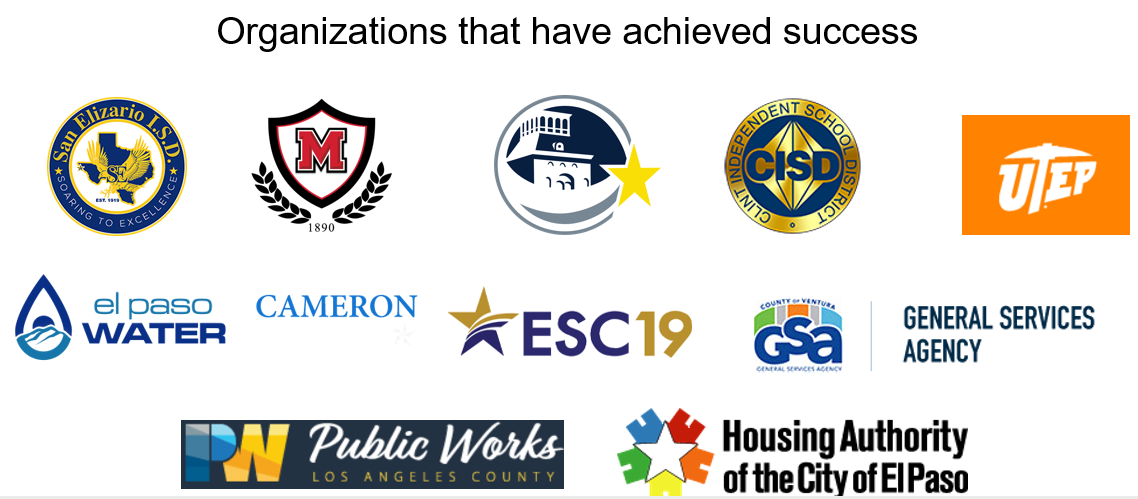
Projects Completed
Happy Clients

As a facilities management professional, you are well aware that 80%-90% of ALL construction projects are late, over-budget, or completed poorly.
(Sources: McKinsey Report, 2018; McKinsey Global Institute (MGI’s) Reinventing Construction:; National JOC Survey and other published reference materials.)
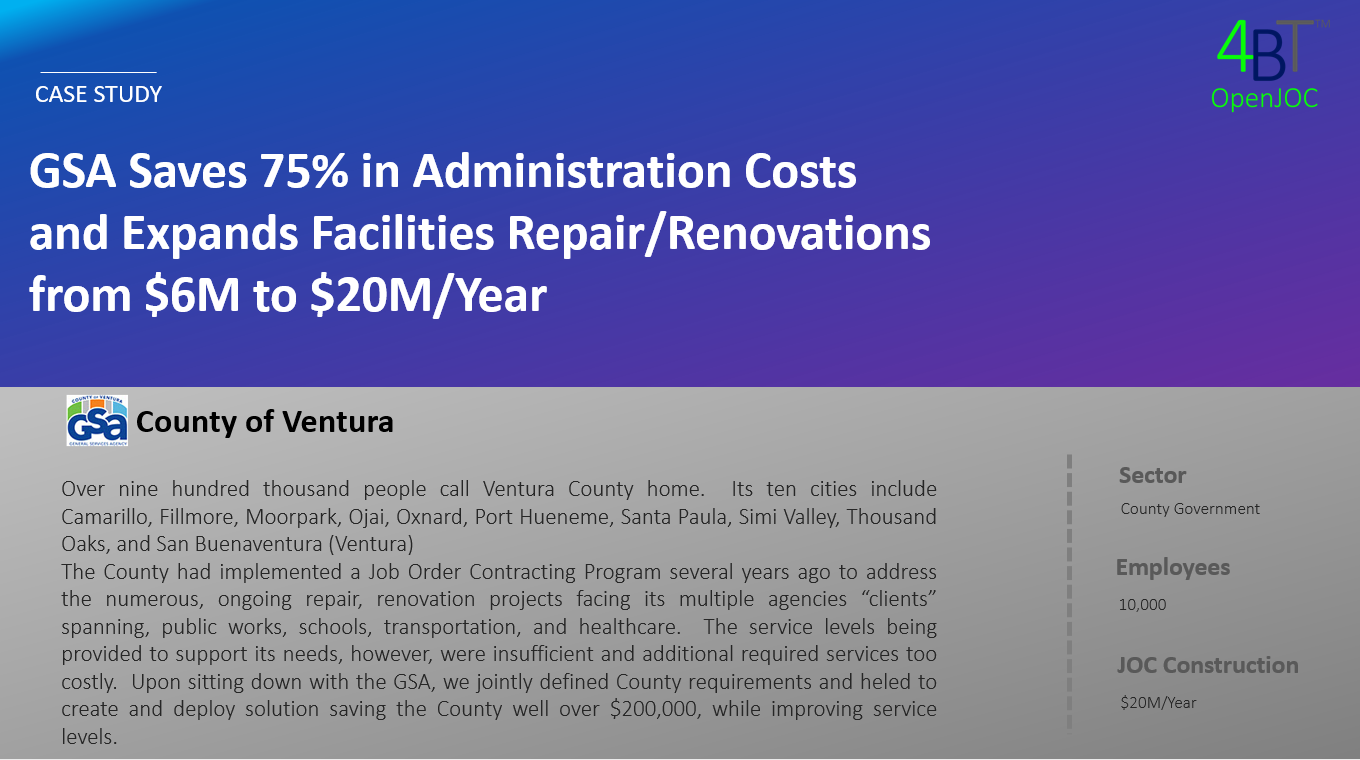
Before
The County of Ventura GSA had implemented Job Order Contracting years ago but was having trouble getting projects scoped, procured, and completed. The level of support and service needed by internal staff proved to be a burden, however, additional support from the current JOC vendor was unavailable or viewed as too costly. The problem was that the County needed to support its multiple client departments, but it could not cost-effectively meet their demands.
After
The County took the time and effort to identify an alternative solution that directly translated to a higher performing facilities repair and renovation capability for the County and its client departments and agencies at a 75% cost savings. We helped them implement a customized solution and repeatable processes to realize current and capture future benefits.
What we hope you take away from this is that we gave them a roadmap, a plan, a suite of tools, and we delivered on it. We addressed their facilities support needs and implemented a sustainable solution. As a result, not only were administrative costs reduced 75%, but the JOC Program expanded from $6M/year to $20M/year.
Timeframe
Set Up - 3 months
Program Experience - 3 years

Story
The Ventura County GSA is a provider of critical support services to multiple public sector "client" departments and agencies. These clients includes schools, hospitals, parks and recreation, first responders, and other public service buildings. The procurement team knew they were having some issues with their facilities construction services support despite having a Job Order Contract in place for several years. They have confidence in the JOC approach but recognized that they were not getting the services needed to reap benefits for their clients.
The client departments and agencies had a critical need to efficiently deal with the numerous ongoing repair and renovation requirements for public safety and meeting other service commitments, but is was frustrating for them to not be able to procure and execute projects in a timely and robust manner.
After completing work with 4BT to develop a workflow compatible with the County's needs, 4BT embedded the process into a secure cloud application. 4BT also built a locally researched, detailed unit price construction cost book, including line items specifically required by the County.
Simplifying the overall JOC process and providing the level of service the County needed virtually eliminated all the the past issues, including client frustrations with lost time dealing with administrative issues. The County could support the needs of its clients and pinpoint exactly the status and value of each project.
Who Is This For?
As a savvy public sector facilities professional we understand that only two things really matter...
1. Ensuring organizational buy-in and adoption of your strategy, and
2. Delivering on a plan to efficiently sustain your facilities requirements.
This is for you if...
-You hate having to wait months to start projects,
-Your FM budget has gone awry, and you are just plain sick and tired of throwing money out the window, explaining why your projects are late, and over-budget, “fighting” with contractors, and “putting out fires” with building users,
-You are spending way too much money on unplanned repairs rather than improvements,
-You know you need better support for your in-house FM team and your AEC vendors,
-You suspect your current construction planning, procurement, and project management system is not up to par,
-You are worried about compliance and financial visibility or transparency,
-You could use help getting your leadership to understand the value of moving to a better way of doing things.
-With your ever increasing need to “do more with less” it’s no surprise you only have time for solutions, not technology or “consulting services”.
Core Concept
Here's the Truth
You can achieve consistent quality projects on-time and on-budget while reducing cost 30%-50% in 90 days with a robust, collaborative process-based solution, instead of continuing inefficient ‘ad hoc’ methods.
Savvy facilities management professionals are establishing high performing internal and external teams, setting the strategy, building the "business case: and leveraging enabling technologies, but there is a problem. If done out of sequence and without the appropriate steps and tools, they find themselves facing a high probability of failure.
We are the best and only company dedicated to solving this problem for public sector facilities owners.
Background Story

Hi, my name is Mark Powell and five years ago I cofounded 4BT. My experience includes serving aboard the U.S.S. Enterprise and subsequently built my career in the construction sector. After spending decades as a construction project manager, it became clear that public sector facilities owners needed a way to procure and deliver projects faster, with better outcomes, and without paying excessive administrative costs. The reality is that any construction project, whether a repair, major renovation, or new project is only successful if it is based upon a robust, integrated, and collaborative process. Having all projects follow a proven process is the only way to assure that information is effectively communicated on an early and ongoing basis throughout the planning, procurement, and project delivery life-cycle and beyond.
Project management is best performed under a standardized program. A robust, process-based program consistently requires that "success" is a shared responsibility among the project team which consists of all the performers; pr
oject managers, team leads, etc. from across internal organization procurement and facilities management units and external design and construction organizations. It is also the responsibility of sponsors, functional managers, clients, executives and senior managers, who set objectives, provide resources and establish and maintain the environment that supports effective performance.
But then, there is a well-kept secret regarding FM Technology. No technology is going to deliver a solution for your organization. Software is only useful if it is based upon a robust process and data is of sufficient quality, clear, and accurate. No software or consultant can solve your problems… without your team doing the work. Your most valuable asset is your people and your team of service partners… empower them to solve the problems themselves. Your organization’s facilities management and procurement professionals and your suite of service providers…architects, engineers, and contractors… all need to be on the same page. The risk of change is high, and technology alone won’t be a fix. Look, we get it. BIM, CAFM, CMMS, ERP, or any “alphabet soup” of technologies. Not one has significantly improved construction productivity or quality outcomes. The issues remain the same regardless of the technology, all the project participants are operating in silos, duplicating information, or worse yet using out of date information, information that can’t be used by others, or data that is just plain wrong. In the end, building users, your customers, are really angry with the result and you have just wasted more of your resources.
This is an opportunity to do something different.
What seems like "common sense", however, is foreign to many organizations. Furthermore, robust solutions, like Job Order Contracting, were largely being supported by "JOC consultants", instead of real property owners. The associated cost, and addition of a "third party" to the mix proved costly and lacking.
So my team and I set out to build a solution that was easy-to-use and implement directly by real property owners, was inexpensive, and bulletproof!
So, together with Peter Cholakis formerly with 4Clicks Solutions, The R. S. Means Company, and VFA, Inc., and Gene Spencer, formerly with The R.S. Means Company, we developed a collaborative LEAN Job Order Contracting solution to do just that.
Or team members have worked with real property owners of all sizes, and their service partners… serving single sites and entire organizations… including the General Services Administration, Public Building Services, Federal Aviation Administration, Clark County School District, MEDCOM, University of Texas San Antonio, and hundreds of others.
So, if you want a no BS solution to drive best value facilities repair, renovation, and new build outcomes that won't break the bank, and will be fully compliant, let's talk about how 4BT might be right for you.

President & CoFounder
Mark Powell

Senior Vice President
Peter Cholakis

Senior Vice President
Gene
Spencer
The Value of a Shared Purpose, Process, and Information Environment
Effectively managing your facilities to support your organization’s mission requires the ability to;
1.) define scope and cost,
2.) procure services, and then 3.) execute projects in a consistently reliable manner. Fully defining a repair, renovation, or new build is critical to success. Studies have clearly demonstrated that a poorly prepared, poorly communicated scope of work is the primary cause of ALL construction project failures. These same studies have shown that the construction delivery method PROCESS impacts all aspects of a project. The Proven Method described here focuses upon creating an environment to support BEST VALUE project delivery on a consistent basis as quickly and efficiently as possible.
We have used this method to support our clients and they have achieved superior outcomes throughout all Planning, Procurement, and Project Execution phases of repair, renovation, maintenance, and new builds.
If you can't describe what you are doing as a process, you don't know what you're doing. - Edwards Deming
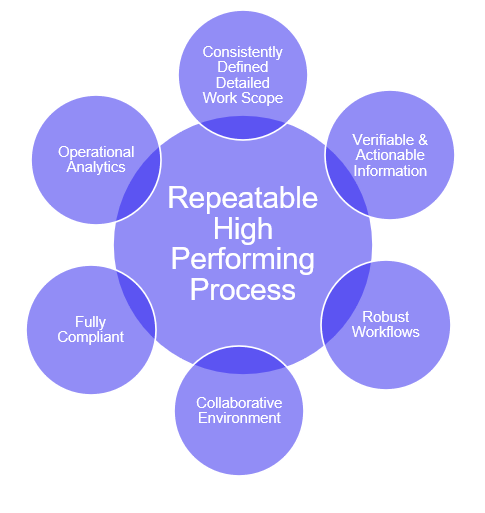
Old Way
While each repair, renovation, maintenance, and new build has its own requirements, they unfortunately have been managed by archaic, ‘ad hoc’, and unsustainable practices.
Each project was procured and managed as its own unique activity, with its own set of tools, unnecessarily duplicating efforts, and without a well-defined, reliable, or verifiable set of phases, milestones, or information requirements.
Old Result
When you wanted to schedule a renovation project you would have to create a scope of work, advertise for bids, review the bids, award a contractor, and try to bring the contractor up to speed on your buildings and work environment. This process would take months, many times nearly a year. The results would be costly in delays, duplicative efforts, and numerous change orders.
New Way
The proven road to measurable improvement is to follow a robust core workflow for EVERY project. Sure, each project has its unique requirements, but following a common work flow assures every team member knows what to do, where, when, and how much it will cost. The process and workflow is detailed and documented in an Operations Manual / Execution Guide, as a part of a long-term multi-party agreement. All documents, forms, schedules, approvals, and information requirements are consistent, and communicated in real-time through an enabling collaborative technology. A common, robust, core workflow is maintained for each and every project. Every project has detailed reliable costs and concrete timelines.
New Result
A consistent way of approaching each project that drives best value outcomes for everyone, with a proven track record of 90%+ of all projects and work orders executed in a quality manner, on-time, and on-budget! The process provides full technical and cost visibility and transparency and is fully auditable and compliant.
Unique Useful Insight
Using a consistent, robust process allows you to create a reliable program that enables owners and their services providers to consistently achieve best value outcomes for everyone.
Do not Take our Word for it Though…
National survey information, case studies, and our clients have implemented a programmatic approach and achieved significant improvements in their construction related facilities management activities throughout all phases of planning, procurement, and construction.
FAQs
Q: Does setting up a workflow for my organization take a great deal of customization and effort?
A: No. The primary phases of the workflow have been proven and are already developed. Customization largely comes in the form of the specific authorization and other documents associated with proposal/bid packages, approval notices, authorizations, etc. Focus on a robust process first and create a common work environment.
Q: Are there various ways to establish a common construction planning, procurement, and project delivery environment.
A: Yes. Research the market and assure what every approach you take will have a financial benefit. Develop a direct link between you new process initiative and the cost benefits. Far too often organizations select a technology, consultant, or a solution without developing a cost benefit analysis for the activity. What happens when organizations do this is that they miss a huge opportunity to get major benefits from the low hanging fruit. Processes get adopted that don’t solve real problems, and overall costs actually increase, with recurring costs that don’t add real value. The market pressures from large technology vendors and consulting companies is strong, so allocate the time up front for planning to avoid the wrong decision and recurring sunk costs. Establishing quantitative goals based upon return on investment is the only way to drive measurable, lasting benefits. So, avoid failure by overinvesting in planning.
Thesis Steps
Step 2 - Assure every Scope of Work (SOW) is detailed and presented in a way that everyone can understand.
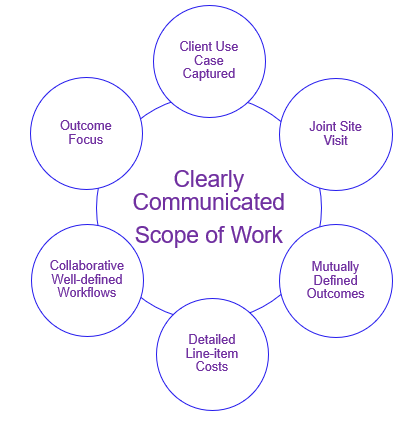
Old Way
For many projects, an owner writes up a scope of work without designer or contractor input. Formats and the level of detail are all over place. Generally, there is little detailed information about actual site conditions, how and what needs to be done for demolition or otherwise getting the site ready for mobilization and construction execution. Costing the activity is little more than an educated guess.
Old Result
As a result the scope of work is poorly defined and poorly communicated. Errors and omissions and change orders are numerous and increased project costs and uncertain project completion times are the norm. In the end, 9 times out of 10, the owner, building users, the designer, and the builder are unhappy.
New Way
With a repeatable process in place, the owners and the service providers meet on-site and share information about the work to be done. In this way, the owner can develop and communicate a detailed scope of work that is sufficient for the builder to create a detailed line-item description of the required work and the cost of each task. Costs and requirements are no longer a shot in dark. The tasks and cost information are derived from a locally researched detailed unit price book (UPB), to which both parties have previously accepted. The UPB describes what is required in terms of an activity with all labor, materials, and equipment for the task itemized individually.
New Result
The detailed scope of work now clearly communicates the project in a way there everyone understands. This process results in fewer errors and omissions, reduced change orders, faster project delivery, and lower costs! All parties fully understand and agree upon the desired result, the cost, and the schedule. Eliminating change orders alone results in a 15%+ reduction of total project costs.
Unique Useful Insight
A well communicated, detailed scope of work is critical to the success up any construction activity.
Do not Take our Word for it Though…
Experts agree that a poorly prepared Scope of Work is the #1 cause of project failure.
FAQs
Q: Does setting up a workflow for my organization take a great deal of customization and effort?
A: No. The primary phases of the workflow have been proven and are already developed. Customization largely comes in the form of the specific authorization and other documents associated with proposal/bid packages, approval notices, authorizations, etc. Focus on a robust process first and create a common work environment.
Q: Are there various ways to establish a common construction planning, procurement, and project delivery environment.
A: Yes. Research the market and assure what every approach you take will have a financial benefit. Develop a direct link between you new process initiative and the cost benefits. Far too often organizations select a technology, consultant, or a solution without developing a cost benefit analysis for the activity. What happens when organizations do this is that they miss a huge opportunity to get major benefits from the low hanging fruit. Processes get adopted that don’t solve real problems, and overall costs actually increase, with recurring costs that don’t add real value. The market pressures from large technology vendors and consulting companies is strong, so allocate the time up front for planning to avoid the wrong decision and recurring sunk costs. Establishing quantitative goals based upon return on investment is the only way to drive measurable, lasting benefits. So, avoid failure by overinvesting in planning.
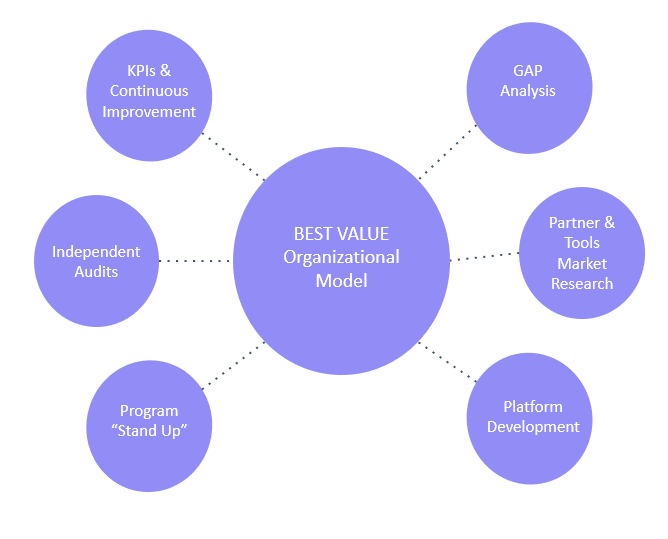
Old Way
You sign up with a JOC services “consultant” and pay a percentage of your total JOC annual construction volume. Based on the services you select; this approach will cost your firm 2% to over 8% of construction volume. This can easily reach millions of dollars for larger JOC Programs, just for administering the program.
Old Result
You pay 2x to 10x more than necessary to implement a JOC Program. The “JOC Consultant” gets in the middle, and in the process ends up fostering the old adversarial relationships associated with design-bid-build. You and your team remain at arm’s length from the awarded JOC contractor. As a result, your team fails to develop leadership and other core JOC benefits. Oversight is compromised and typical results are poor. JOC Program benefits fail to justify the costs, and your facilities management team is left to pick up the pieces.
New Way
You assess your needs and properly research the market to either select select a JOC Cooperative (if your annual construction volume is under $2M to $3M), or set up your own JOC Program. In both cases you select only the products and services you need and maximize value. As the your selection is compliant with all applicable regulations and that every contractor proposal is independently audited.
New Result
The cost for all tools and services is 3x to 10x less than paying a percentage fee and your organization builds with you and your internal and external service provider teams retain and grow critical competencies and drive continuous improvement.
Unique Useful Insight
Direct owner participation, support, and understanding are critical to value achievement. Public sector organizations can improve the results of their facilities repair, renovation, maintenance, and new build activities by spending more time openly learning and communicating the core principles of Job Order Contracting. The core benefit, and difference in our approach is treating everyone involved as "equal partners" in the process, which in turn greatly increases internal knowledge and greatly enhances JOC Program success. During this process, it is important to gain management support and understanding. Both are critical. This is true as well as all participants internal to the organization… facilities management professionals, procurement, project management, and building professionals. JOC is a fundamental change in how people work together on a day-to-day basis. It is important for everyone to be directly involved, without the buffer of a “consultant”, so that they can actually “feel it to understand it and believe it.”
Do not Take our Word for it Though…
Multiple audits of JOC Programs have been conducted by independent third-party agencies. A review of these audits clearly highlight what can happen if owner teams do not learn fundamental JOC principles and directly engage in proven JOC processes. This link will direct you to a sampling of these JOC Program audits.
FAQs
Q: What type of training is required to set up an “owner-managed process’?
A: Is important for you, as the owner, to fully understand fundamental principles, process, and workflows. These are neither complex, nor time consuming. It’s important to note that your program will continuously improve and adapt over time. You will likely phase in the new process over the first two years.
Q: What tools and services are generally required?
A: Introductory training and ongoing training is mandatory for all participants and stakeholders. This will be a new way of working for many. Software that embeds your processes, and locally researched detailed unit price cost data are also requirements.
Q: Isn’t it more costly to set up an owner-managed program?
A: Initial costs are higher, however, overall program costs are 3x to 10x lower than an “outsourcing” approach..
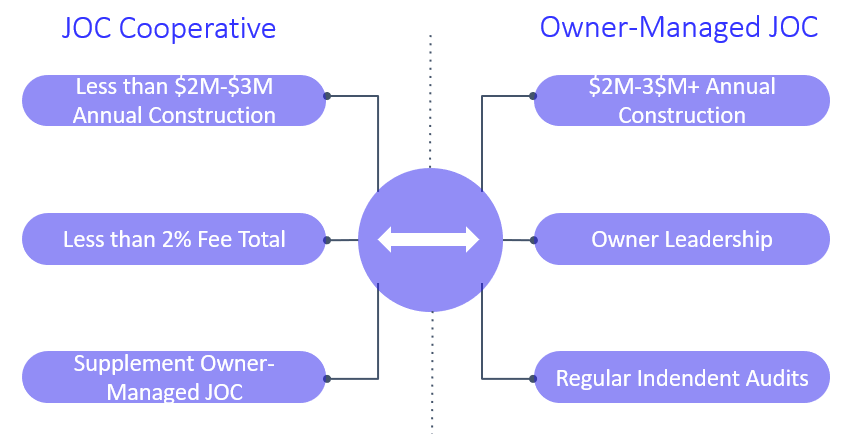
Old Way
JOC Cooperatives began to add construction services to the list of “commodities”, like paper, pencils, and computers, that public agencies can purchase in bulk. Fees for these services range from 2% to 8%+ of the construction value.
Old Result
Construction is clearly not a commodity, and fees charged to the Owner, JOC Cooperative, or Contractors of more than 2% are extremely costly. Also, these fees clearly end up being paid by you, the Owner.
New Way
JOC Cooperatives are used by owners to learn about JOC, in situations where total JOC construction volume is less than $2M-$3M annually, or to supplement an existing house program. You properly research the JOC Cooperative to assure it is compliant with all applicable regulations and that every contractor proposal is independently audited for compliance.
New Result
Owners appropriately leverage JOC Cooperatives in concert with their level of knowledge and demand for appropriate repair, renovation, and new build construction services.
Unique Useful Insight
Repair, renovation, maintenance, and new construction activities are not commodities. While JOC Cooperatives play a role, they are not appropriate long-term solutions for all public sector owners.
Do not Take our Word for it Though…
Do your homework and carefully review the fees being charged to contractors, If more than 2%, remember that owners inevitably pay for the increased cost. Also carefully evaluate the services being provided to assure compliance with applicable regulatory requirements.
FAQs
Q: Are all JOC Cooperatives the same?
A: No. Some JOC Cooperatives are owned or managed by for profit private corporations. These may have different motivations than those managed directly for government agencies. Also, some cooperatives charge owners or JOC contractors excessive fees, up to 8%+ of the project construction volume. Look for a government agency owned and managed JOC with no fee to cooperative members and no more than 2% to JOC contractors. Also assure that every contractor proposal is independently audited, and that the UPBs involved are locally researched and regularly updated.
NOW THERE ARE A FEW WAYS YOU ACHIEVE THIS...
OPTION #1 - Do it yourself
You can do the research and try to dig through all the information and hype to learn how to structure a robust and integrated construction planning, programing, and project delivery process. Then, you can set out to develop your own locally researched detailed unit price construction cost book. Of course, you will also need to develop a collaborative technology to host your newly developed process and tools.
Result:
You will slog up a difficult learning curve, make needless mistakes, and progress toward an uncertain outcome.
Price:
$1M+
Time:
1 year minimum, likely 2-3 years.
OPTION #2 -Go the traditional "JOC consultant" route
You can hire a JOC consultant and pay them a percentage of your annual repair, renovation, and minor new build budget and have them "manage" your program.
Result:
You will put a third party between you and your team and your design/build contractors. By doing this you will miss a core benefit, the opportunity to build and maintain a long-term direct relationship with your builders. You will not build and maximize the knowledge of your internal and external teams. The fees you pay will not be directly proportional to the tools and services you need to simply build and manage your program.
Price:
$1M-$3M/Yr. (approximately 2% to 8%+ of annual construction volume.
Time:
6-12 months

Before
The County of Ventura GSA had implemented Job Order Contracting years ago but was having trouble getting projects scoped, procured, and completed. The level of support and service needed by internal staff proved to be a burden, however, additional support from the current JOC vendor was unavailable or viewed as too costly. The problem was that the County needed to support its multiple client departments, but it could not cost-effectively meet their demands.
After
The County took the time and effort to identify an alternative solution that directly translated to a higher performing facilities repair, renovation capability for the County and its client department and agencies at a 75% cost savings. We helped them implement a customized solution and repeatable processes to realize current and capture future benefits.
What we hope you take away from this is that we gave them a roadmap, a plan, a suite of tools, and we delivered on it. We addressed their facilities support needs and implemented a sustainable solution. As a result, not only were administrative costs reduced 75%, but the JOC Program expanded from $6M/year to $20M/year.
Timeframe
Set Up - 3 months
Program Experience - 3 years

Story
The Ventura County GSA is a provider of of critical support services to multiple public sector "client" departments and agencies. These clients includes schools, hospitals, parks and recreation, first responders, and other public service buildings. The procurement team knew they were having some issues with their facilities construction services support despite having a Job Order Contract in place for several years. They have confidence in the JOC approach but recognized that they were not getting the services needed to reap benefits for their clients.
The client departments and agencies had a critical need to efficiently deals with the numerous ongoing repair and renovation requirements for public safety and meeting other service commitments, but is was frustrating for them to not be able to procure and execute projects is a timely and robust manner.
After completing work with 4BT to develop a workflow compatible with it client's needs, 4BT embedded the process into a secure cloud application. 4BT also build a locally researched, detailed unit price construction cost book, including line items specifically required by the County.
Simplifying the overall JOC process and providing the level of service the County needed virtually eliminated all the the past issues, including client frustrations with lost time dealing with administrative issues. The County could support the needs of its clients and pinpoint exactly the status and value of each project.

You will consistently plan, procure, and execute quality projects on-time and on-budget.


You will have improved financial and technical visibility and transparency.

You will reduce the complexity common with traditional 'ad hoc' methods and follow a consistent robust process for all projects.

You will stop wasting time with needless duplication of effort and avoidable errors, omissions, and miscommunications.

You are going to feel relieved as you can now focus on those important initiatives that have continually been back-burnered by daily fiascos.
So, in summary….
You will be able to scope and procure projects in weeks, not months!
Procure and execute projects in a fraction of the time!
You will save at least 20%-30% in administrative and overall project costs by eliminating repetitive, inefficient procurements and virtually eliminating change orders!
Collaborate in real-time from a single source of truth!
Manage documents - View and review current documents and forms digitally!
Manage Programs, Contracts, Projects, Proposals/Bids/Estimates, Work Orders, Buildings and Locations, Teams!
Follow a consistent, proven process for all projects!
Work towards mutually beneficial outcomes!
Contribute to project success!
Maintain a fully auditable and compliant program!
Allocate a higher percentage of funds to actual construction!
Build long-term relationships based upon trust and performance!
Continuously improve!
Complete more projects with the same or even less resources!
You will be able to dedicate more resources on actual repair/construction than on administration and legal disputes!
You can phase in your improved processes over time. Begin with a few sample projects then move to full implementation when you and your teams are ready!
You can set up your own program in as little as 90 days!
You can finally minimize, if not eliminate, the internal complaints about projects being late, shoddy work, not to mention the antagonistic relationships with contractors!
You will feel like you are making a difference instead of treading water because you are!
You will build and maintain a suite of local, skilled, reliable design/builders!
You will be in full compliance and have a full audit trail!
You will finally get rid of having to deal with a constant stream of construction project failures and complaints!
You will feel empowered to improve your department and its impact upon the organization!
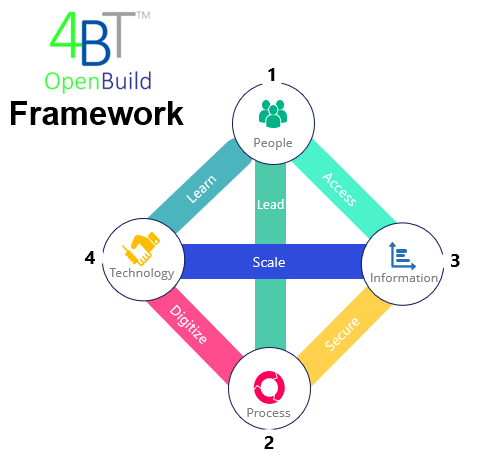
Before, when you wanted to take advantage of the benefits of integrated planning, procurement, and project delivery available from a well designed and well managed JOC Program, you would have had to pay a “JOC Consultant” a percentage fee of your construction value.
But now, you can simply work with us to set up your JOC Program. You select and purchase the tools and training you need without paying and excessive fees linked to the construction dollars your spend.
Your risk of failing to gain all the available for JOC is also minimized. We sit down with you and your team, review your current processes, perform a GAP analysis, and jointly tailor a JOC Program that has a workflow and toolset that is right for your organization.
Do you see how easy we have made it for you?
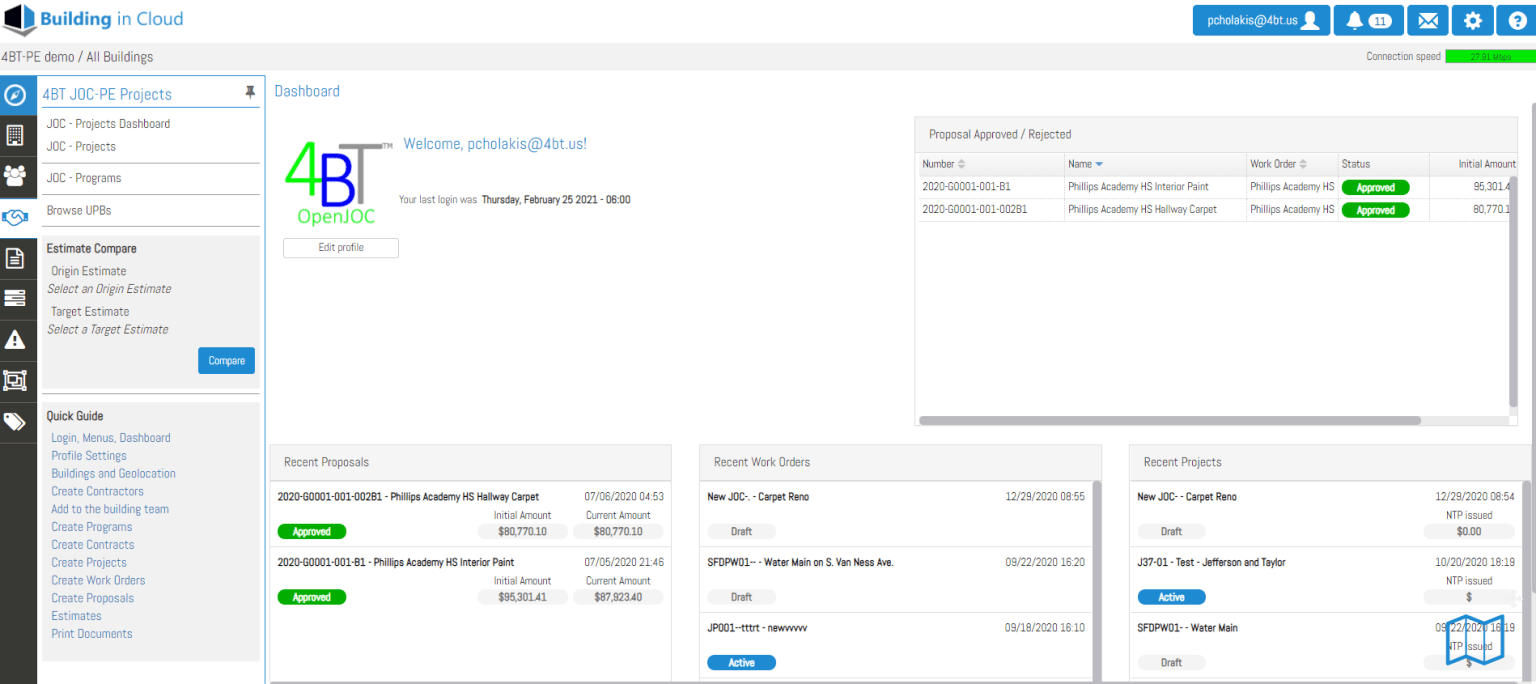
REAL-TIME PROGRAM MANAGEMENT
Before, when you were asked to check on the status of contractor bids, individual projects or work orders, the amount of your budget expended or committed versus available, or your minority business participation, you would panic… review a variety of outdated reports from multiple sources, and place multiple calls to contractors or your team, only to get voicemail.
But now, you can see all your programs, projects, work orders, and more at a glance. Then drill down to any level of details you needed. You can even download all your current and historical data at any time and create your own reports.
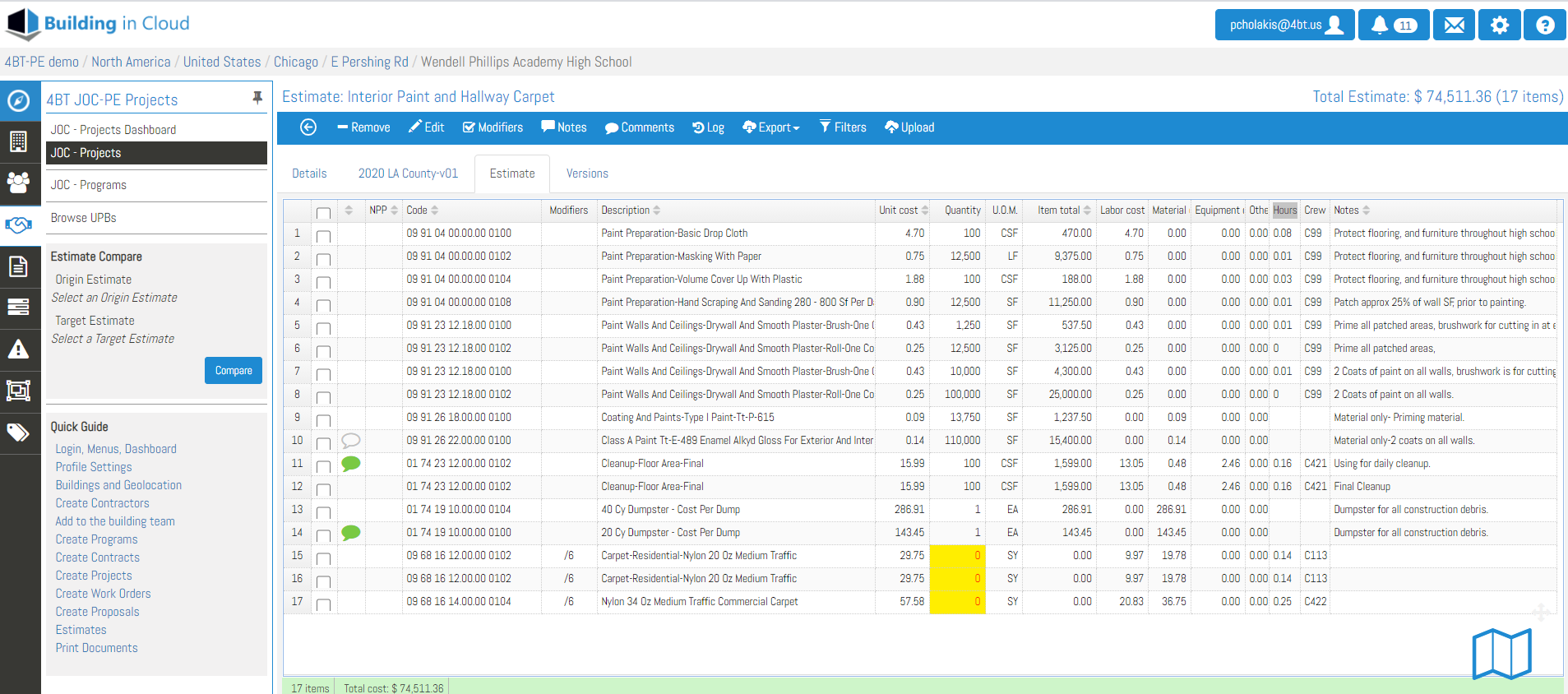
Before, when you wanted to scope a project from a cost and technical perspective you would have to rely upon a hodgepodge of historical information, national average cost reference data, and subcontractor quotes. This process was not only time consuming but rarely, if ever, gave you a reliable cost of what you wanted to accomplish.
But now, you can simply select the line item tasks you need for your project and simply insert the quantities. This information is easily shared, reviewed, and understood by everyone! Do you see how easy we have made it for you?

Before, if you wanted to get a renovation project started, you had to spend months while you... find the funds, advertise a request for proposal (RFP), sort through the proposals, award a contract, then finally start the project. Even after doing all that, you only had a 10%-20% chance that the project would be done correctly and without complaint from building users or design/builders, and the project being late, or over-budget, or both. You spent months trying to get the work done, and spent, on average 20-30% more than you had to.
But now, you can get a project approved and awarded in a few weeks, with a pre-established budget and suite of reliable builders. You get the work done right and save tons of time and money. Preapproved, service-oriented, skilled contractors are "on-call" schedule a joint site visit with you and then deliver a detailed line item cost estimate in a couple of weeks. A robust workflow assures rapid information flow and meeting project requirements.
Supporting Cloud-Based Environment
Now what I am going to do is show you a quick video introduction to our 4BT-PE Cloud Solution for Owners Our 4BT-PE cloud solution integrated planning, procurement, and project delivery platform that enables facilities to systematically organize, collaborate, and leverage actionable information to consistently drive on-time, on-budget, quality outcomes working with the design/builders, for all of your facilities repair, renovation, and new build initiatives.
Log-on to get started….
Instantly you have access to a comprehensive dashboard we key insights to all your facilities projects and work orders….
Easily drill down to view, create, or approve individual projects, estimates, or work orders….
View, understand, and immediately address any issues....
Align all internal and external teams … procurement, project managers, contractors, and subs… to drive maximum efficiencies.
Request a no obligation trial today..
For 1/10 the Cost of Traditional Solutions We Can Offer
WARNING - This offer will be limited to ten (10) organizations for 2021.
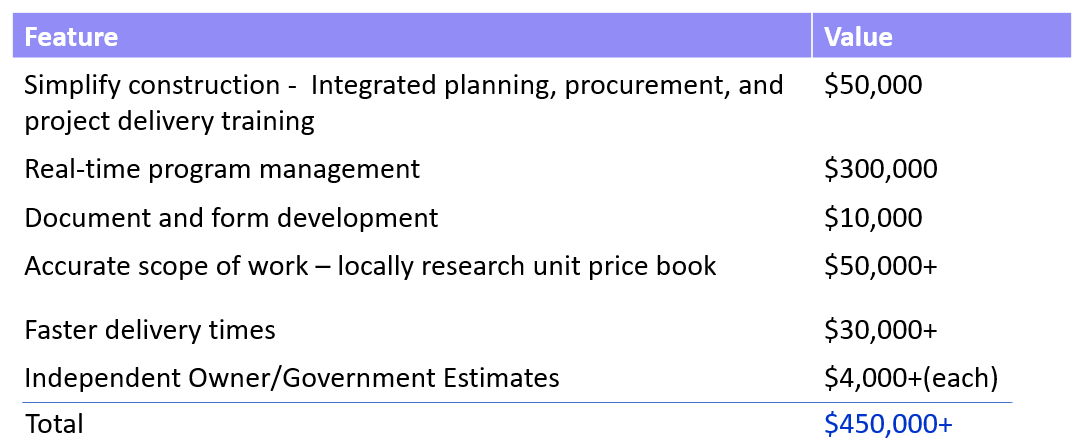
*You are getting $450,000-$1M worth of value and we're offering this at 1/10th of the price you would normally have to pay.
Lets get in touch!
We know a personal touch makes all the difference. Give us a ring during office hours and we'll help you however we can.
+1 (903) 326 9965
Monday - Thursday
8am - 6pm (PT)
Friday
8am - 5pm (PT)
Can’t wait? Drop us a note now!
Making construction simpler and driving consistent best value outcomes, one project at a time.
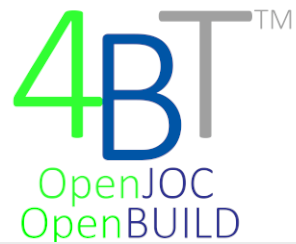
Four BT, LLC
303 Riverwood Lane
Dunsmuir, CA 96025
www.4bt.us
Frequently Asked Questions
#1 Why should I bother, I already have a JOC Program?
I totally understand, but let us show you how others have saved 75% to 10x in program administration costs, while able to triple their annual JOC program volume.
#2 I have seen other cost estimating software and databases, and they appear less expensive, why should I consider your solution?
Generic cost estimating software doesn’t address the processes, workflows, and information requirements of a JOC Program. For example, a JOC Program involves; Locally Researched Construction Cost Cata, Program Management, Contract Management, Proposal/Bid and Estimate Management, Automated Proposal Comparisons, Collaborative Proposal Reviews, Project Management, Work Order Management, Document Management, WBE/MBE Tracking, Contractor Management, Issues/Task Management, Team Management, Site/Location Management, BIM Integration….
#3 Will this work if I don’t have relationships with JOC contractors in my area?
A good JOC contractor needs to be service oriented, willing to go the extra mile to make long-term relationships work for both parties. Experience with JOC is not as important as a contractor’s willingness to be a true partner. We will work with you to market your JOC Program to local contractors, and provide all the training needed for them to excel.
#4 What if I don’t have it in my budget to set up a JOC Program, isn’t it easier to just pay for a JOC Program on a percentage fee out of my operational budget?
The cost to set up a JOC Program is likely in the $60-$80K range for the Owner. Contractors generally pay for their own software and training. The cost of the program generally is recaptured in the first few projects due to fewer change orders, more refined scopes of work, and other efficiencies. Furthermore, a percentage fee JOC Program can cost 10x more in the long run. That excessive cost would be hard to justify for any public sector professional.
#5 Will this work if I have no experience with JOC?
Yes. The only factor that matters is that you and your leadership understand and are willing to support the fundamental principles of JOC. Support services and training will enable your team to build upon its current expertise and learn JOC-specific activities.
#6 I, and my team, really don’t like change. Isn’t there risk involved in changing from our current processes?
All people are wary of change. That said, the real question is what will happen if you don’t change? How long can you or your organization continue to waste funds and allow deferred maintenance to grow unchecked because you are spending too much on unscheduled activities?
#7 Do I need to make a full change of my repairs, renovation, and new building activities?
You can phase in as many JOC projects and work orders as you’d like. There is no minimum amount of work that you need to do. Many first time JOC users begin with an total annual spend of about $2M-$3M with an average individual JOC project of about $150,000.
#8 Are long-term contracts required?
Our JOC tools, software and cost data, are based upon an annual subscription. Services are provided on an as needed, per requirement, basis. There are no long term commitments. A JOC Program is usually awarded to JOC Contractors for one year, with annual renewals or option years (at the owner’s sole discretion) spanning up to four additional years. Throughout this timeframe, however, there is generally no minimum amount of construction volume required of the owner.
#9 What if I have multiple locations throughout the city, county, state, or country? Will this work for me?
Generally, “yes”, based upon your organization and applicable statutes. We have many clients that have multiple sites to be served. In these cases, there may be multiple unit price books needed to account for local market conditions, and/or appropriate local contractors.
#10 My organization is pretty conservative, how can I convince my boss to start a JOC program with you, or switch my existing one?
It’s really quite simple. If you are happy with your current situation, you wouldn’t be considering us. You already know you need to “do more with less”, and better serve your organization. We can help you with information to support your “business case”. More importantly, take a look at the backgrounds of our team. Look at who we currently are serving.
#11 Our organization is in a different time zone, how do I get support?
First and foremost, our goal is to simplify JOC. We have done just that. Our technology is hosted on world class servers with amazing backup capabilities. We have people on the east coast and west coast, and mountain states and are capable of providing 24/7 support as required.
#12 Are there special skills or additional criteria required to establish and manage a successful JOC Program?
Owners must have leadership skills and a degree of competency with respect to LEAN collaboration construction planning, procurement, and project delivery. Unlike traditional construction procurement and project delivery, JOC operates optimally within an environment of mutual trust and respect, shared risk and reward, and a focus upon best value outcomes for all participants and stakeholders. The ability to build and understand detailed line item cost proposals and estimates is also required. Remember, people and process come first!
#13 How many JOC Contracts do I bid?
You can develop and bid a single “general construction” contract or several contracts based upon geographic area and/or type of work required, for example: Texas JOC, Texas Region 1 JOC, New Mexico JOC, Roofing JOC, Paving JOC, Fencing JOC, Electrical JOC.
#14 Are JOCs awarded via lowest bidder or best value?
Owners may elect to award JOCs to responsible and eligible bidders bidding the lowest coefficients per the solicitation. We, however, suggest that a best value approach be used. This approach considers the bidders previous work history as well as the coefficient.
#15 How are individual JOC Projects (or work orders) priced?
Pricing for individual projects/work orders are based upon the 4BT OpenJOC Unit Price Book and the subsequently applied contractor’s JOC coefficient. The coefficient (or multiple coefficients), serve as an adjustment factor to the applicable unit price book(s) approved for the JOC. For instance, a coefficient of 1.20 would represent a 20% “markup” to the UPB. The coefficient generally includes all project general conditions as described in the contract, such as general supervision, overhead and profit. Projects are scoped and priced as part of the process described in the contract. Once a project is approved, the price becomes a lump sum price for the project.
#16 How often should a unit price book, UPB, be updated, and how?
A unit price book must be updated as stipulated in contract documents. That said, best management practice is to update the UPB at least annually for labor, material, and equipment updates, including the addition of any approved new line items. Updating labor on a more frequent basis and adjusting materials based upon major shifts should also be considered.
#17 Is the 4BT OpenJOC Unit Price Book similar to a national average price book and the associated use of location factors?
No. The 4BT OpenJOC Unit Price Book has been locally researched for the specified usage area(s). We do not recommend the use of commercial and/or national average reference price books. National average cost books introduce gross cost errors.
#18 What items should be included in a JOC estimate?
All JOC estimates should include all allowable costs, which a prudent and experienced contractor would expect to incur. Any design costs (if applicable) are the responsibility of the JOC contractor as well as all construction efforts needed for project completion. Cost must include consideration of performance specifications, deliveries, site preparation, access, cleanup, and other such items not included in the plans and specifications but would be part of the costs a prudent contractor would expect to incur.
#19 What are prevailing wage requirements?
Labor rates required for the JOC Program are typically specified in the JOC RFP and associated contract. Prevailing wage rates represent an average wage rate in a particular geographic region. How prevailing wage rates are calculated, and which prevailing wage rate source to be used, should be specified. Davis-Bacon Wage Rates are required for federal government projects and/or those using federal funds. They also generally provide a reasonable approximation of local prevailing wage rates. It is critical that labor is locally researched and that national average data not be used. States may also publish prevailing wages rates to be used for all related state, county, or local JOC programs.
#20 Do Job Order Contracts support Minority and Women-owned businesses?
Studies of JOC in the federal government have shown that JOC increases opportunity for small and disadvantaged businesses. The type of work performed under a JOC should provide opportunities for emerging businesses, whether they serve as prime contractors or trade subcontractors. Note that not all JOCs allow for subcontractors.
#21 What differentiates your products and services from your competitors?
We founded 4BT in 2016 upon seeing a clear need to rethink, reshape, and rebuild JOC. We believe… 1. LEAN planning, procurement, and project delivery processes should be deployed in a manner that is mutually beneficial to all participants and stakeholders, 2. Full cost visibility and transparency and compliance must be provided, 3. JOC solutions should not burden users with excessive fees and costs, and 4. Cost data should reflect local market conditions.
#23 Where are you located and in what region of the US do you conduct business?
No. The 4BT OpenJOC Unit Price Book has been locally researched for the specified usage area(s). We do not recommend the use of commercial and/or national average reference price books. National average cost books introduce gross cost errors.
#24 What training do you offer, and do you provide free software trials to real property owners?
4BT offers free trials of our SAAS technology, inclusive of our locally researched construction cost data to any owner interested in a JOC Program. Multi-level, and multi-level training is available including on-site, virtual, regional, advanced and introductory.
#25 Is there a specific project management software or estimating software that works best with your data?
Our 4BT SaaS technology stands can provide full “data dumps” in a standardized format for virtually any systems. That said, our technology can fully support your JOC Programs operational requirements, including Program Management, Contract Management, Proposal/Bid Management, Estimate Management, Document Management, Location Management, Building Management, Asset/Component Management, and Contractor/Subcontractor Management, as well as the ability to integrate BIM information and view BIM models.
#26 Do you sample contractors pricing in any given area to confirm accuracy of your cost data?
Yes, we sample local contractor pricing. We research all aspects of local market conditions using our 4BT cost research methodology. We research local labor trades inclusive of fringes, material costs, and equipment costs within targeted areas. If we find a variance of 5% or greater in areas in which work is being done, we create a separate UPB.
#27 Does your software take into consideration of how contractors prepare a coefficient?
Yes. We believe a properly researched UPB should enable a contractor to submit a co-efficient of greater than 1.0. For example, if a UPB should reflect the local cost of construction minus contractor profit and overhead. Thus a contractor's bid co-efficient for standard hour construction is generally in the 1.10-1.30 range.
#28 What additional support services do you offer?
Our customers include real property owners and managers, builders, cooperatives, and private companies, therefore our support services vary. A partial listing of our support services would include:
JOC Program Development
JOC Program Oversight, Including Formal and Informal Compliance Audits
JOC SaaS Technology Customization
Multi-level and Multi-format training
24/7 JOC Technology and User Support Services – Online, Phone, Email.
#29 Does your software factor for multiple coefficient usage? (Example: Standard Hours, Non-Standard Hours and Non-Pre-priced Items)?
Yes. Our SaaS technology supports multiple co-efficients and then associates and locks co-efficients to specified JOC contract and awarded contractors. Non-prepriced items are automatically tracked and in terms of both identification and usage.
#30 Non-Pre-priced Items tend to be commonly used. What is the capability of your software to incorporate non pre-priced items? Is it included in your service or an additional service charge?
Our technology enables the creation and use of non-prepriced line items. Most importantly the UPB itself is locked and can only be changed per contract specifications. Additional non-prepriced line items can be easily created from existing UPB line times at a detailed level, include changes to material, labor, crew, and equipment costs. All changes at noted and maintained perpetually. All non-prepriced line item are automatically tagged as such, and there used is track and calculated. For example, a proposal will note the dollar are percentage of non-prepriced line items as well as highlight their individual usage. All of the above are included within our standard pricing.
#31 What are the reasons for the failure of a JOC Program and/or poorly performing JOC Program?
The primary reason that a JOC Program fails to deliver significant benefit to an owner and its participants is poor initial goal setting and poor initial program set up and training. Proper expectations must be established for owners, participants, and stakeholders. The goal of a JOC Program should not be solely to expedite procurement of construction projects, but rather, more efficient project planning, procurement, and project delivery on an overall basis. Failure to require initial and ongoing (at least annual) training is another reason for poor performance. A JOC Program should require regular independent third-party audits., the lack of which has created significant issues. Lastly, the improper or excessive use of JOC consultants can set the landscape for fundamental performance, cost, or legal issues. For example a JOC consultant should never be compensated based upon a percentage of JOC construction volume if the consultant is responsible for approving JOC projects.
#32 How are the cost data items maintained and how often are they updated? Do they become a normal line item priced annually in future annual price book revisions?
The 4BT UPB is changed based upon JOC contract requirements. That said, we recommend that labor be updated quarterly, and the UPB be updated annually for mutually approved (owner and 4BT) line item additions. Approved annual additions of line items become part of the standard UPB for the associated JOC.
#33 Can your unit price book be localized by market values directly related to a specific City without using historical national averages but rather localized averages based on a specific location’s historic cost and not adjustment to a dataset?
4BT’s UPB’s and cost databases are always locally researched. We do not use national averages or cost factors. The use of national averages and cost factors can introduce significant error in cost data.
#33 What is a unit price contract?
A procurement for construction services whereby the contractor is paid for the actual quantity of each line item performed as agreed upon by the owner. Each unit price includes all labor, material, equipment, overhead, and profit attributable to that scope of work.